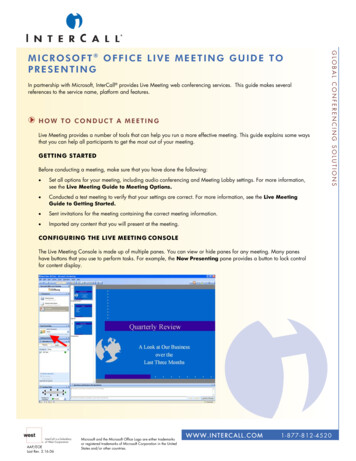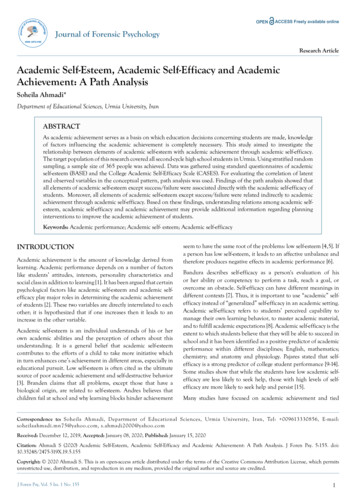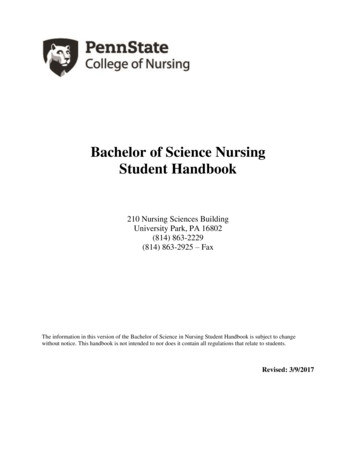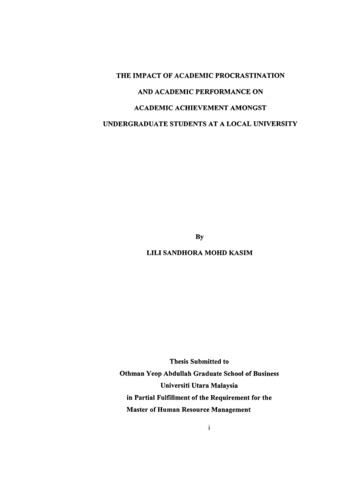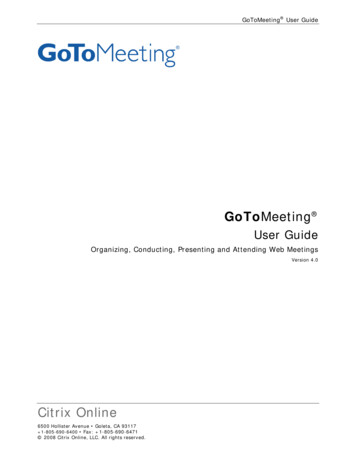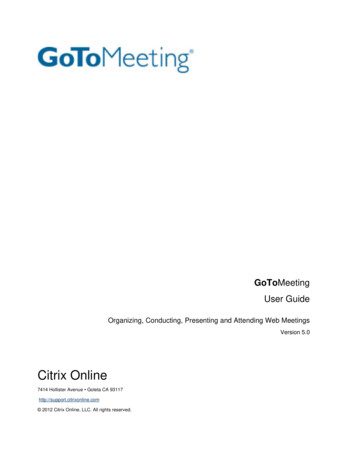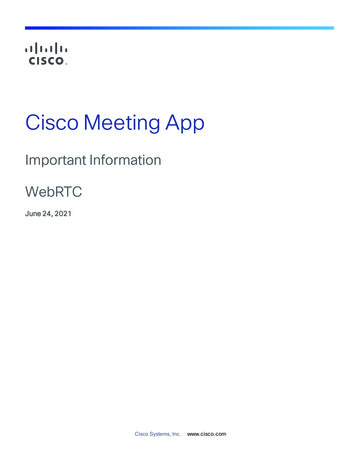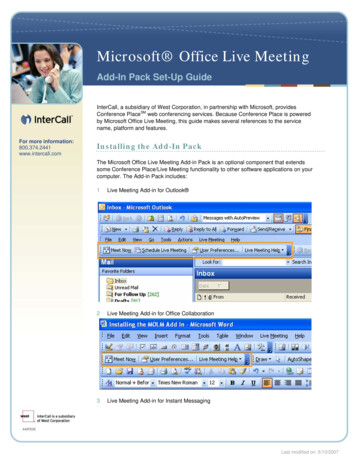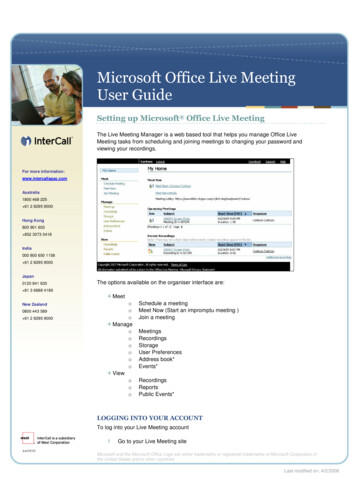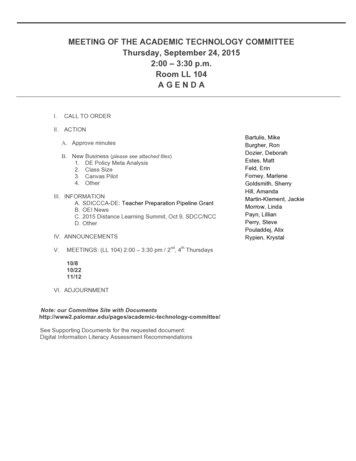
Transcription
MEETING OF THE ACADEMIC TECHNOLOGY COMMITTEEThursday, September 24, 20152:00 – 3:30 p.m.Room LL 104AGENDAI.CALL TO ORDERII. ACTIONA. Approve minutesB. New Business (please see attached files)1. DE Policy Meta Analysis2. Class Size3. Canvas Pilot4. OtherIII. INFORMATIONA. SDICCCA-DE: Teacher Preparation Pipeline GrantB. OEI NewsC. 2015 Distance Learning Summit, Oct 9, SDCC/NCCD. OtherIV. ANNOUNCEMENTSV.ndthMEETINGS: (LL 104) 2:00 – 3:30 pm / 2 , 4 Thursdays10/810/2211/12VI. ADJOURNMENTNote: our Committee Site with chnology-committee/See Supporting Documents for the requested document:Digital Information Literacy Assessment RecommendationsBartulis, MikeBurgher, RonDozier, DeborahEstes, MattFeld, ErinForney, MarleneGoldsmith, SherryHill, AmandaMartin-Klement, JackieMorrow, LindaPayn, LillianPerry, StevePouladdej, AlixRypien, Krystal
1. DE Policy Meta Analysis2. Class Size3. Canvas PilotNote: The following files are not in any particular order. Thank you for your contributions to this research!DE POLICY META ANALYSISPALOMAR COLLEGE CURRENT DE POLICY:(Note that this is not a Board Policy, but a Curriculum Policy from the CurriculumCommittee/Instruction Office, based on Title 012/11/Regular- ‐Effective- ‐Contact- ‐Policy- tatorofstudentlearning.Inaface- ‐to- withviathetelephone,email,orface- ‐to- econtactdescribedabovefortheface- ‐to- scribedbelow:1. nsideredthe“virtualequivalent”offace- ‐to- torcontacthoursperweekthatwouldbeavailableforface- ‐to- twillensurethatregularcontactismaintained,given
priateforthecourse.2. 010- oninathreadeddiscussionboardParticipationinanopen- groupcollaborationprojectsFace- ‐to- ‐faceinformalmeetings(e.g.reviewsessions)Face- ‐to- tive2010- ‐2011AcademicYearPalomar Community College District Procedure AP 4105 INSTRUCTIONAL -12.pdfAP 4105 DISTANCE EDUCATION References:Title 5 Sections 55200 et seq.Definition
Distance education means instruction in which the instructor and student are separated by distance andinteract through the assistance of communication technology.Course ApprovalEach proposed or existing course offered by distance education shall be reviewed and approvedseparately. Separate approval is mandatory if any portion of the instruction in a course or a coursesection is designed to be provided through distance education.The review and approval of new and existing courses offered through distance education shall follow thecurriculum approval procedures outlined in AP 4020 titled Program and Curriculum Development.CertificationWhen approving courses to be offered though distance education, the Curriculum Committee will certifythe following: Course Quality Standards: The same standards of course quality are applied to the courses offeredthrough distance education as are applied to traditional classroom courses. Areas that are part of theDistance Education Review process include:ooooStudentAccesstoResourcesStudent ServicesInterventionandRemediationRecommendations o Test SecurityAcademicIntegrity Course Quality Determinations: Determinations and judgments about the quality of the courseoffered through distance education are made with the full involvement of the Curriculum Committee. Instructor Contact: Each section of the course that is delivered through distance education willinclude regular effective contact between instructor and students.Date SPC Approved: 5/15/20121of2Palomar Community College District Procedure AP 4105 Accessibility Standards:Electronic course materials, e-textbooks, websites, andcourse packs must be accessible to individuals with disabilities.Validation of preparedness to teach online may be determined in one or more of the following ways: Evidence of successful completion of the “Online Preparedness Training at Palomar” series ofworkshopsEvidence of coursework, certificates, and/or degrees that focus on online teaching which werecompleted at other accredited higher education institutionsEvidence of a successful evaluation of the course with the “Online Best Practices Checklist”
Duration of ApprovalAll courses offered through distance education approved under this procedure will continue to bein effect unless there are substantive changes of the course outline.Office of Primary Responsibility: Faculty Senate and Instruction OfficeDate SPC Approved: gular- ‐Effective- ‐Contact- ‐Policy- a.edu/ distance/ojdla/spring61/levy61.htmFaculty guidelines from Michigan CChttp://www.mccvlc.org/ staff/content.cfm?ID s/Distance ED policy manual.pdfhttps://berkeleycollege.edu/files bc/Distance Learning fective1-19-10Revised6-1813 ttp://www.westga.edu/ distance/ojdla/fall173/keil brown173.html Southeasterjn Louisiana State University:
sets/distance education.pdfAugusta Technical College: This a rather detailed document that includes student evaluations toassess outcomes at the completion of an online ce ED policy manual.pdfCLASS SIZEPALOMAR COLLEGE CURRENT Class Size lPALOMAR COMMUNITY COLLEGE DISTRICT POLICY BP 4675 INSTRUCTIONAL SERVICESBP 4675 CLASS SIZE Reference:No referencesClass size (course minimums and maximums) shall be determined through negotiations between theDistrict and the Palomar Faculty Federation (PFF).Date Adopted: 11/10/2009 (Replaces current Palomar College Policies 309 and 309.1)----------------------------------- "Class Size and Interaction in Online Courses"http://prozy.palomar.edu/login?url http://search.ebscohost.com/login.aspx?direct true&db aph&AN 22941927&site ehost-live&scope site "A Framework for Evaluating Class Size in Online Education"http://prozy.palomar.edu/login?url http://search.ebscohost.com/login.aspx?direct true&db aph&AN 70303053&site ehost-live&scope site "Does Class Size Matter?"http://prozy.palomar.edu/login?url http://search.ebscohost.com/login.aspx?direct true&db aph&AN 103007655&site ehost-live&scope siteStudent research paper that might have sources that could be useful id 005&vid 4939/Not positive this has class size, but I couldn't skim more to viewer?sid 003&vid urvey Online Class Size.pdfhttp://eric.ed.gov/?id 4512/4621309/Survey Online Cl
ass Size.pdfhttps://books.google.com/books?id A0ECyUIVkMC&pg PA127&lpg PA127&dq online class size best practices&source bl&ots 9RhwdnvA9G&sig X yvAJu5B38Hmu1i202qiM5zSJ8&hl en&sa X&ved 0CFoQ6AEwB2oVChMIr8PJ97LtxwIVAjuICh07MAp#v onepage&q online%20class%20size%20best%20practices&f uidlines for good practice n.pdfFrom Grand Rapids CC in andardsquality0This page to find that they cap classes at 22!"ENROLLMENT CAPACITYBy GRCC Faculty Contract enrollment for online classes will be nogreater than 22 students per hments/faculty contract.pdfThis more current resource states:"On-line Course Instructiona. The enrollment for on-line classes will be no greater than twentythree (23) students persection.b. If the administration requests a faculty member to overload anonline class and the facultymember accepts, the formula to determine the rate of pay for theadditional student(s)shall be as follows:1/15 x # of students x # of contact hours for the class x the overloadrate4. Hybrid Course Instructiona. The enrollment for hybrid classes will be no greater than twentythree (23) students persection.b. If the administration requests a faculty member to overload a hybridclass and the facultymember accepts, the formula to determine the rate of pay for theadditional student(s) shall
be as follows:1/15 x # of students x # of contact hours for the class x the overloadrate bstract:Abstractor:NumberofReferences:Numberof Pages:Publication umber:An Examination of the Relationship between Online Class Size and Instructor PerformanceSorensen, ChrisJournal of Educators Online, v12 n1 p140-159 Jan 2015. 20 pp.YesOnline Courses, Class Size, Teacher Competencies, Correlation, Feedback (Response), Teacher Student RelaThinking, Teacher Expectations of Students, Expertise, Part Time Faculty, Observation, College Faculty, ScorEducation, Postsecondary EducationWith no physical walls, the online classroom has the potential to house a large number of students. A concecourses with high enrollments. The purpose of this research was to examine online class size and its relationperformance. Results were mixed indicating that class size had a positive relationship with some the variablenegative relationship with others. Online class size was seen as having the most concerning relationship andfeedback to students and for his/her expertise to be used consistently and effectively.As Provided2820Journal Articles; Reports - ResearchFull Text from ERIC Available online: CServlet?accno EJ1Journal of Educators Online. 500 University Drive, Dothan, AL 36303. Web site: tlink ogin?url http://search.ebscohost.com/login.aspx?direct true&db eric&AN EJ10Cut andPaste: a href "http://prozy.palomar.edu/login?url http://search.ebscohost.com/login.aspx?direct true&db eric&of the Relationship between Online Class Size and Instructor Performance /a Database:ERICRecord: 2
rs:Abstract:Abstractor:NumberofReferences:Numberof Pages:Publication ionNumber:Class Size and Interaction in Online CoursesOrellana, AnymirQuarterly Review of Distance Education, v7 n3 p229-248 2006. 20 pp.Yes1528-3518Class Size, Online Courses, Interaction, Teacher Attitudes, College Faculty, Undergraduate Study, GraduateEducation, Postsecondary EducationThis article presents findings of a study conducted to determine instructors' perceptions of optimal class sizeImplications for research and practice are also presented. A Web-based survey method was employed. Onlinyears by a single instructor in undergraduate or graduate programs from U.S. higher education institutions.most recently taught online course using a Web version of Roblyer and Wiencke's (2004) Rubric for Assessinoptimal class sizes according to such qualities. Responses from 131 instructors were analyzed. On average (interactive, (b) the actual class size of the online courses was 22.8, (c) a class size of 18.9 was perceived asinteraction, and (d) a class size of 15.9 was perceived as optimal to achieve the highest level of interaction.sizes and their actual level of interaction. (Contains 5 tables.)As Provided5420Journal Articles; Reports - ResearchIAP - Information Age Publishing, Inc. P.O. Box 79049, Charlotte, NC 28271-7047. Tel: 704-752-9125; d 89&i 9FEB20142010EJ875034Persistentlink ogin?url http://search.ebscohost.com/login.aspx?direct true&db eric&AN EJ87Cut andPaste: a href "http://prozy.palomar.edu/login?url http://search.ebscohost.com/login.aspx?direct true&db eric&Interaction in Online Courses /a Database:ERIC
rs:Identifiers:Abstract:Abstractor:Numberof Pages:Publication ionNumber:Online, Bigger Classes May Be Better ClassesParry, MarcEducation Digest: Essential Readings Condensed for Quick Review, v76 n4 p19-22 Dec 2010. 4 pp.N/A0013-127XForeign Countries, Online Courses, Electronic Learning, Class Size, Privacy, Access to Education, Distance EdEducational Environment, Influence of Technology, Context Effect, Higher EducationCanadaIn his work as a professor, Stephen Downes used to feel that he was helping those who least needed it. Hisleg up in life and could afford the tuition. When a colleague suggested they co-teach an online class in learnwelcomed the chance to expand that privileged club. In an experiment that could point to a more open futu1,200 noncredit participants last year. The Downes-Siemens course has become a landmark in the small butthe Massachusetts Institute of Technology have offered free educational materials online for years, but the nexperience, too. However, not everything about open learning is revolutionary. The question is whether opeeducators who haven't taken the plunge yet are interested, but also cautious. Like many institutions, the Unmaterials, such as lecture slides and syllabi. But Gary W. Matkin, dean of continuing education, says he cana separate space. Partly, he says, it's about student privacy, but also about setting a learning context for pais structured. Lori Wallace, dean of extended education, notes that open teaching is up against academe's hownership.ERIC4Journal Articles; Reports - DescriptivePrakken Publications. 832 Phoenix Drive, P.O. Box 8623, Ann Arbor, MI 48108. Tel: 734-975-2800; Fax: 734http://www.eddigest.com/sub.php?page contentsFEB20142011EJ913282Persistentlink ogin?url http://search.ebscohost.com/login.aspx?direct true&db eric&AN EJ91Cut andPaste: a href "http://prozy.palomar.edu/login?url http://search.ebscohost.com/login.aspx?direct true&db eric&Classes May Be Better Classes /a http://www.tc3.edu/docs/hr/uc faculty.pdf
Tompkins Cortland Community College in New York, per their contractcaps online classes at same level as f2f" A Distance Learning section is credited to a faculty member’s totalload the same as any nondistancelearning section of the same course." p 47NOTE- They do provide separate compensation for s/ClassCapsS12 0.pdfThe Academic Senate for CC resolved in 2012 that the enrollmentsizes for DL should be local decision but made no suggestions forideal nos. (cf. p. mberof Pages:Publication ionNumber:PersistentUsing Interactive Content and Online Activities to Accommodate Diversity in a Large First Year ClassSnowball, J. D.Higher Education: The International Journal of Higher Education and Educational Planning, v67 n6 p823-838Yes0018-1560Class Size, Teaching Methods, Large Group Instruction, Case Studies, Higher Education, Student Attitudes, BAcademic Achievement, Socioeconomic Background, Economics, Economics Education, Computer Assisted InAs in many universities, class sizes have increased more quickly than teaching and learning resources. A relaterms of socio-economic background, learning styles, English language ability and preparedness. This papermethods (such as lectures and tutorials) can be combined with online teaching and learning activities in a "band to accommodate student diversity. Using a large first year Economics class as a case study, data were cA statistical model was used on a sample of 50 students to determine which online activities were most benstudents agreed that replacing one lecture a week with online activities and resources improved their learninmore lecturing and fewer online resources. Statistical finding showed that more active online resources, sucbeneficial in improving student performance, but that more passive lecture capture was also useful in modelAs Provided2916Journal Articles; Reports - ResearchSpringer. 233 Spring Street, New York, NY 10013. Tel: 800-777-4643; Tel: 212-460-1500; Fax: 2http://prozy.palomar.edu/login?url http://search.ebscohost.com/login.aspx?direct true&db eric&AN EJ10
link tothisrecord(Permalink):Cut andPaste: a href "http://prozy.palomar.edu/login?url http://search.ebscohost.com/login.aspx?direct true&db eric&Interactive Content and Online Activities to Accommodate Diversity in a Large First Year Class /a Abstract:Abstractor:NumberofReferences:Numberof Pages:Publication umber:Persistentlink tothisrecord(Permalink):An Examination of the Relationship between Online Class Size and Instructor PerformanceSorensen, ChrisJournal of Educators Online, v12 n1 p140-159 Jan 2015. 20 pp.YesOnline Courses, Class Size, Teacher Competencies, Correlation, Feedback (Response), Teacher Student RelaThinking, Teacher Expectations of Students, Expertise, Part Time Faculty, Observation, College Faculty, ScorEducation, Postsecondary EducationWith no physical walls, the online classroom has the potential to house a large number of students. A concecourses with high enrollments. The purpose of this research was to examine online class size and its relationperformance. Results were mixed indicating that class size had a positive relationship with some the variablenegative relationship with others. Online class size was seen as having the most concerning relationship andfeedback to students and for his/her expertise to be used consistently and effectively.As Provided2820Journal Articles; Reports - ResearchFull Text from ERIC Available online: CServlet?accno EJ1Journal of Educators Online. 500 University Drive, Dothan, AL 36303. Web site: ozy.palomar.edu/login?url http://search.ebscohost.com/login.aspx?direct true&db eric&AN EJ10
Cut andPaste: a href "http://prozy.palomar.edu/login?url http://search.ebscohost.com/login.aspx?direct true&db eric&of the Relationship between Online Class Size and Instructor Performance /a rs:Student Evaluation of Instruction: In the New Paradigm of Distance mberof Pages:Publication ionNumber:Persistentlink tothisrecord(Permalink):itle:Author(s):Source:Liu, Ou LydiaResearch in Higher Education, v53 n4 p471-486 Jun 2012. 16 pp.Yes0361-0365Class Size, Academic Rank (Professional), Student Evaluation, Distance Education, Models, Academic AchievLearning, Sample Size, College Faculty, Teachers, Higher EducationDistance education has experienced soaring development over the last decade. With millions of students incritically important to understand student learning and experiences with online education. Based on a largecolleges and universities, this study investigates the factors that impact student evaluation of instruction in dfindings reveal that in a distance education setting, gender and class size are no longer significant predictorstaking the course, student class status and instructor's academic rank have a significant impact on student eoffer important implications for institutional administrators on utilizing the evaluation results and on developinstructors.As Provided4216Journal Articles; Reports - ResearchSpringer. 233 Spring Street, New York, NY 10013. Tel: 800-777-4643; Tel: 212-460-1500; Fax: http://prozy.palomar.edu/login?url http://search.ebscohost.com/login.aspx?direct true&db eric&AN EJ96Class Size and Interaction in Online CoursesOrellana, AnymirQuarterly Review of Distance Education, v7 n3 p229-248 2006. 20 pp.
NumberofReferences:Numberof Pages:Publication ionNumber:Yes1528-3518Class Size, Online Courses, Interaction, Teacher Attitudes, College Faculty, Undergraduate Study, GraduateEducation, Postsecondary EducationThis article presents findings of a study conducted to determine instructors' perceptions of optimal class sizeImplications for research and practice are also presented. A Web-based survey method was employed. Onlinyears by a single instructor in undergraduate or graduate programs from U.S. higher education institutions.most recently taught online course using a Web version of Roblyer and Wiencke's (2004) Rubric for Assessinoptimal class sizes according to such qualities. Responses from 131 instructors were analyzed. On average (interactive, (b) the actual class size of the online courses was 22.8, (c) a class size of 18.9 was perceived asinteraction, and (d) a class size of 15.9 was perceived as optimal to achieve the highest level of interaction.sizes and their actual level of interaction. (Contains 5 tables.)As Provided5420Journal Articles; Reports - ResearchIAP - Information Age Publishing, Inc. P.O. Box 79049, Charlotte, NC 28271-7047. Tel: 704-752-9125; d 89&i 9FEB20142010EJ875034Persistentlink ogin?url http://search.ebscohost.com/login.aspx?direct true&db eric&AN EJ87Cut andPaste: a href "http://prozy.palomar.edu/login?url http://search.ebscohost.com/login.aspx?direct true&db eric&Interaction in Online Courses /a Title:Author(s):Source:PeerReviewed:ISSN:Online, Bigger Classes May Be Better ClassesParry, MarcEducation Digest: Essential Readings Condensed for Quick Review, v76 n4 p19-22 Dec 2010. 4 pp.N/A0013-127X
of Pages:Publication ionNumber:Persistentlink tothisrecord(Permalink):Cut andPaste:Foreign Countries, Online Courses, Electronic Learning, Class Size, Privacy, Access to Education, Distance EdEducational Environment, Influence of Technology, Context Effect, Higher EducationCanadaIn his work as a professor, Stephen Downes used to feel that he was helping those who least needed it. Hisleg up in life and could afford the tuition. When a colleague suggested they co-teach an online class in learnwelcomed the chance to expand that privileged club. In an experiment that could point to a more open futu1,200 noncredit participants last year. The Downes-Siemens course has become a landmark in the small butthe Massachusetts Institute of Technology have offered free educational materials online for years, but the nexperience, too. However, not everything about open learning is revolutionary. The question is whether opeeducators who haven't taken the plunge yet are interested, but also cautious. Like many institutions, the Unmaterials, such as lecture slides and syllabi. But Gary W. Matkin, dean of continuing education, says he cana separate space. Partly, he says, it's about student privacy, but also about setting a learning context for pais structured. Lori Wallace, dean of extended education, notes that open teaching is up against academe's hownership.ERIC4Journal Articles; Reports - DescriptivePrakken Publications. 832 Phoenix Drive, P.O. Box 8623, Ann Arbor, MI 48108. Tel: 734-975-2800; Fax: 734http://www.eddigest.com/sub.php?page u/login?url http://search.ebscohost.com/login.aspx?direct true&db eric&AN EJ91 a href "http://prozy.palomar.edu/login?url http://search.ebscohost.com/login.aspx?direct true&db eric&Classes May Be Better Classes /a dia/objects/4512/4621309/Survey Online Class Size.pdfI love these two articles because they place the ideal class size at
18-22 which is what I have just naturally have always said, from myexperience, is an ideal class size!Interesting, isn't rms:Company/Entity:Abstract:Full TextWord Count:ISSN:AccessionNumber:Big Classes Encourage Experiments in Teaching. (cover story)Glenn, DavidChronicle of Higher Education. 3/12/2010, Vol. 56 Issue 26, pA1-A11. 4p. 2 Color Photographs.Article*CLASS size*CLASSROOM management*COMPOSITION (Language arts) -- Study & teaching (Higher)*WEB-based instruction*EDUCATIONAL innovations*HIGHER educationCALIFORNIACALIFORNIA State University, ChicoThe article discusses the large numbers of students in classes at California State University in Chico
Validation of preparedness to teach online may be determined in one or more of the following ways: Evidence of successful completion of the "Online Preparedness Training at Palomar" series of workshops Evidence of coursework, certificates, and/or degrees that focus on online teaching which were



